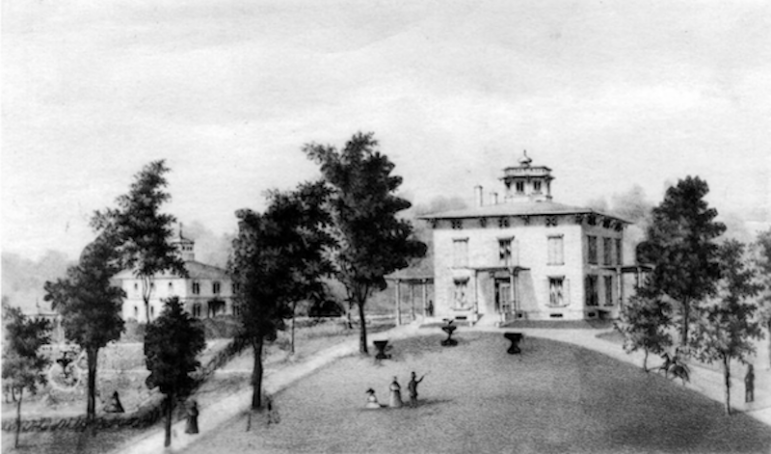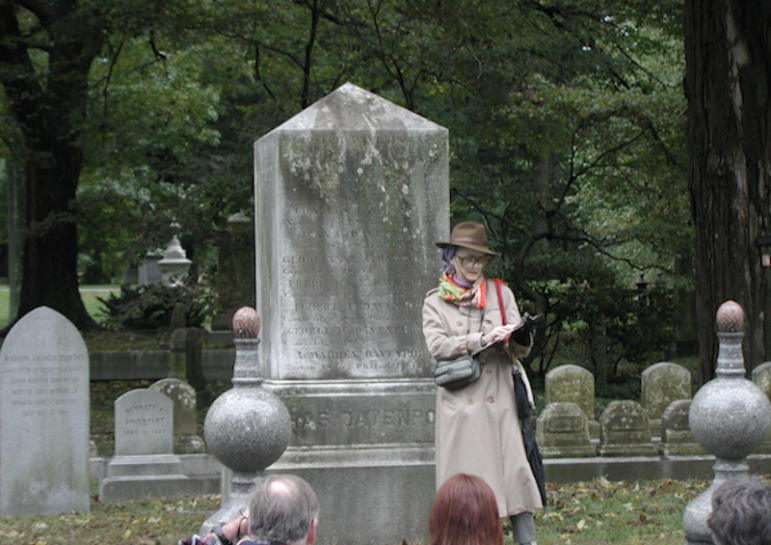
The following article is part of a series on local history provided by the Historical Society of Watertown. It was written by Historical Society President Marilynne Roach for the April 2012 Historical Society newsletter, “The Town Crier.”
In 2005 the Friends of Mount Auburn and the Historical Society of Watertown cosponsored a guided walking tour of Mount Auburn Cemetery in celebration of 375th anniversary of Watertown’s founding. During the walk members of the Historical Society Council and volunteers spoke about the lives of some of Watertown’s notable figures now buried at the Cemetery.
The following article was written by Marilynne Roach and read at Davenport’s gravesite. Charles Davenport (1813–1903) began as a woodworker in the carriage building trade. Seeing the future of transportation, he partnered with Capt. Ebenezer Kimball who owned a stage coach line that ran between Boston and Cambridge. They built an omnibus in 1834 to replace the usual stagecoach style: a longer vehicle entered from the end with an aisle between the seats.
Eventually this street-car style led to rail road passenger cars similarly arranged – in contrast to overseas models with a series of compartments along one side and an aisle on the other (like the Hogwort Express). While the company was located in a Central Square workshop, one of their ads read:
Kimball & Davenport
Cambridgeport, Mass.
Rail Road Passenger Cars, Omnibuses
Barouches, Carryalls, Chaises and Buggies
Constantly on hand and made to order.
Soon enough their buggies made way for rail road cars for this was the golden age of railroad building. As Davenport Car Works the company relocated to a new complex in East Cambridge with access to the river and its own rail spur in an area now owned by MIT. Its foundries built engines that could pull 5 passenger coaches at the blistering speed of 45 mph, while the freight
engines traveled 15 mph hauling 100 cars each loaded with 5 tons of coal. The company sold $4 million worth of RR cars to over 50 different rail roads. Because Charles also invested in some of those rail roads he lost a fortune when the boom burst. However, he held patents on various vital parts of rail road car construction and made a respectable amount to retire on when the company was sold in 1855. (The buildings later housed a boiler factory, Alexander Graham Bell’s experiments, and a fledgling Polaroid. It was only recently been demolished.)

Davenport, at the ripe old age of 45 retired to his country estate in Watertown on the eastern slopes of Meeting House Hill (just below the present Oakley Country Club). He built a 2-story bracketed Italianate mansion with porches and a cupola, a summer house, a 2-story barn (also with a cupola), and a fountain complete with statues. This impressed the locals and gave the estate the name “Fountain Hill.” In 1858 he donated a plot of land to the town – the triangle at the junction of School and Belmont Streets – site of the former school house – on condition the old school building be removed and the plot remain open common forever. (This was at the beginning of communities paying attention to open spaces.) Charles’ son – Dr. Bennett Davenport – was a founder of the Historical Society of Watertown.
Davenport sold Fountain Hill in 1860 to shipping magnate Alvin Adams who enlarged the house considerably – but that’s another story.
THE DAVENPORT DELTA
The Davenport Delta on School Street at the junction of Belmont Street has been a hot topic recently. It was named as part of the Trapelo Road /Belmont Street Corridor Project. The plans included removing a portion of the land in order to widen School Street, taking down several trees, and putting a bus shelter on the Belmont Street side. Due to the joint efforts of many people in Watertown, spearheaded by School Street resident Nancy O’Leary, the Davenport Delta is no longer part of the project and will remain preserved and protected as the unique green space it is today.
The Historical Society of Watertown was part of the preservation effort. A letter was written by our President, Marilynne Roach, regarding the historical importance of the delta and Charles Davenport’s intention for its future. The following is part of that letter:
Historically, this Delta was the location for one of Watertown’s earliest school houses, and is the town’s first public park, established in 1859 when people only just began to realize the importance of preserving open space in a rapidly industrializing world. The park’s name honors its donor, Charles Davenport whose inventions transformed railroad rolling stock from passenger cars to engines. Both he and his son, Dr. Bennett Davenport, advocated for open space along the Charles River and elsewhere for the benefit of all citizens.
The Town named the delta “Davenport Delta” in 1902, according to that year’s Town Report, and unanimously voted to place it and the other parks “upon record as public parks and permanent recreation grounds.”
In addition, Davenport had deeded the land as a gift to Watertown November 19, 1858 with the following stipulation.
“But on condition that the said inhabitants shall remove said School house within four months from the date of this instrument, and that the said Lot shall never be built upon, or occupied by any building of whatever kind but remain and be used solely as a common forever.”